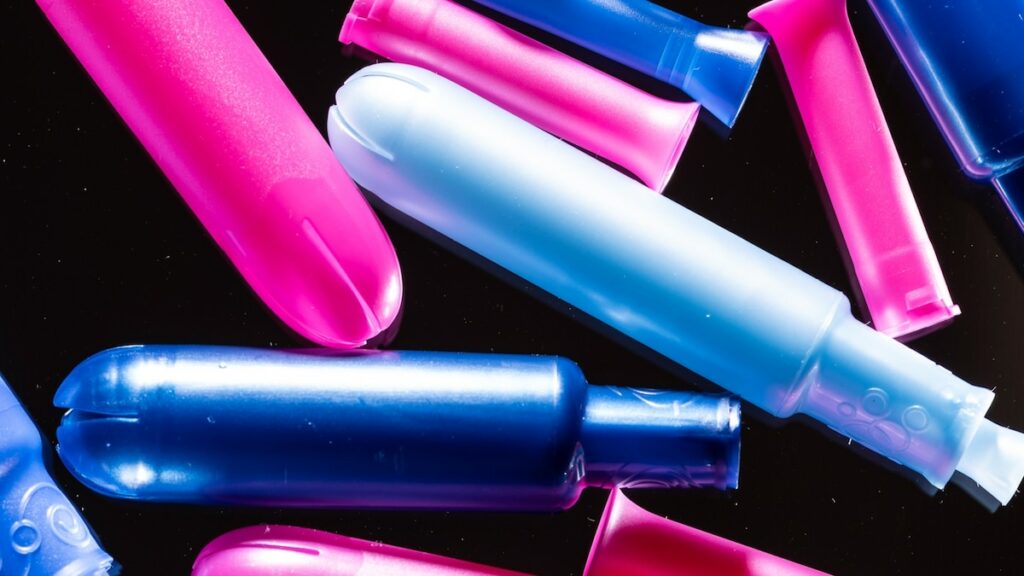Exposure to arsenic—sometimes known as the “king of poisons”—and lead—potentially responsible for the madness of Van Gogh—can be fatal. So a wave of concern has spread across social media following a study that revealed tampons contain arsenic, lead, and other heavy meals. But how worried do we actually need to be?
In the new study, researchers analyzed the levels of 16 metals in 30 tampons from 14 different brands. They found 12 of those metals, including toxic ones, in all products tested. “We found lead, for example, in 100 percent of the tampons we tested,” says lead author Jenni Shearston, an environmental epidemiologist at the University of California Berkeley.
Despite tampons being on the market in the U.S. for more than 90 years, the study authors think this is the first time anyone has tested them for heavy metals. Shearston attributes this to the historical taboo around menstruation. “If we don’t talk about periods or menstrual products, then we may not ask important scientific questions too,” she says.
Here’s what lead, arsenic, cadmium, and other contaminants in tampons might mean for your health—and other common ways you might not know you’re being exposed.
The king of poisons
In Victorian times, arsenic was in everything from clothes and wallpaper to candles and fake flowers, but it was eventually phased out of use after doctors realized exposure was killing people.
Known as the “king of poisons,” arsenic trioxide was even a choice murder weapon because the tasteless and odorless poison, which causes stomach cramps, vomiting, and diarrhea, was undetectable. Just a pea-sized amount could kill.
Lead poisoning, which can also be fatal, can cause joint pain, headaches, difficulty concentrating, and changes in behavior. “It impacts the nervous system, cognition, and brain development,” says Shearston.
Exposure to lead-based paints caused “painter’s madness,” which some believe may have affected Michelangelo and Van Gogh.
When do toxins become harmful?
So, could arsenic and lead in tampons be harming our health?
Sarah Cady, senior research manager at Iowa State University, who wasn’t involved in the study, thinks the presence of these metals isn’t concerning if concentrations are low. “The dose makes the poison,” she says.
Bethany Bannow, associate professor of medicine in the division of hematology and oncology at Oregon Health & Science University (OHSU)—also not involved in the study—thinks it’s unlikely harmful levels of metals could get into our bodies this way. “The tampon is meant to absorb not be absorbed from,” she says.
Bannow adds that the finding wasn’t a huge surprise because “tampons are made from cotton, which grows in the ground. These metals are in the ground.”
But the study revealed high levels of lead—10 times more than the U.S. Environmental Protection Agency’s limit for drinking water. It’s not the perfect comparison, Shearston says, because “we don’t drink tampons, we use them vaginally,” but notes that the vagina has lots of blood vessels and a large surface area, which help with absorption.
Despite recent interest in the vaginal delivery of drugs, how much can be absorbed is an understudied area. “We absolutely need more research,” says Shearston.
(How tampons and pads became so unsustainable.)
Scientists don’t fully understand how vaginal absorption differs from eating contaminants. “The gut is designed to process and absorb nutrients in a way that the vagina obviously isn’t,” says Bannow.
But when food passes the gut, what’s been absorbed “goes to the liver to be detoxified before they get circulated throughout your body,” says Shearston, and this might not happen with vaginal absorption, so toxic substances might not get filtered out.
More research is now planned to find out how this lab work translates to the processes within the human body. “Bodies are weird and [in the lab] you cannot totally imitate what is inside a body,” says Cady.
Until then, “we just don’t know if it’s a health risk yet,” says Shearston. “I know it’s such an unsatisfying answer.”
Where else are contaminants found?
This new example of contaminants in our everyday lives is concerning to Robin Dodson, a research scientist at Silent Spring Institute, who wasn’t involved in the study. “There is no safe level of lead,” she says.
Today, heavy metals are found in everyday items: arsenic can be detected in seafood, contaminated drinking water, and cereals, while lead can be present in the air, soil, and dust.
Recently, cinnamon applesauce packets were recalled because of high levels of lead and chromium. “That’s a major concern to me. I have little nieces, and they love those things,” says Cady.
“We are exposed to hundreds of chemicals of health concern on a daily basis,” says Dodson. In a 2012 study, she found hormone-disrupting chemicals linked to conditions such as fibroids and breast cancer in cosmetics, cleaners, and sunscreens.
“Linking specific chemicals to specific health impacts is tricky because we are exposed to a soup of chemicals from various sources,” she says. Sometimes effects are cumulative—“we don’t just use one product at a time and exposures can add up,”—and we might encounter the contaminant years before the first symptoms.
Tampon use could be an example of low dose chronic exposure, says Shearston: “People use tampons for up to eight hours at a time…for days in a row,” each month for decades.
Although more research is needed, and not all the experts are worried, people can switch menstrual products if this finding makes them nervous. “There’s pads, there’s cups, there’s period underwear, there’s all kinds of things,” says Bannow. “But if tampons work well for people, I think they should absolutely continue to use them.”
For Shearston, “we’re concerned, but it’s not time to panic. It’s not time to throw all your tampons away.”
>>> Read full article>>>
Copyright for syndicated content belongs to the linked Source : National Geographic – https://www.nationalgeographic.com/science/article/lead-arsenic-heavy-metals-tampons
